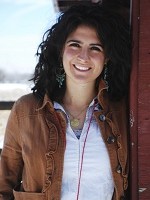Holding her gun with a big grin, a woman shoots a round of bullets into the mountain mist. I scream and dive under a log. Around me, my hosts laugh. “What are you doing, Buket Hanim?” they tease. Although the sight of me squeezing under a log is funny, they kindly put away the gun, and coax me out from my hiding place.
We are at the edge of Turkey, on a 3,000-meter high (close to 10,000 feet) mountain crest somewhere between Savsat, Macahel, and Georgia. My hosts, 20 or so village people from Camili, have taken me into the mountains for a day of driving trucks, grilling meat, loving nature and telling stories. The time that foreigner dove behind a log is quickly becoming a new favorite.
The gunshots send me running, but I feel safer here than I do in most cities.
My hosts are kind beyond all belief, and they eagerly make me feel at home, high in the icy breath of Turkey’s mountains. They wave a chunk of cheese near my log and lure me out from my hiding spot.
Within minutes, a feast is perched on a tray on my lap. The adjectives thick, creamy, white, stringy, boiled, dried, pungent, spongy, yellow, and salty rearrange themselves in front of dairy and corn, resulting in every variety of cheese, yogurt, and bread.
Everything is so fresh, it tastes as though it was milked from the clouds. Shaking from the cold, I effortlessly down thousands of calories in hopes that warmth will follow.
Mist passes through my body, and upon hitting the thick wall of cheese and bread in my stomach, it leaves a wake of shivers and goose bumps on my arms. I stare: at the ghost figures of clouds transforming around me; at the goats’ horns curling into question marks above their heads; at the exotic flowers whose sheer existence in this land of extremes is a miracle.
I have had a creeping suspicion over the last few months that I have fallen into a world where magic is infused into reality. Where science, folklore, and tradition are welded together to create a reality that puts “super” before natural.
The locals spend all afternoon telling me stories that confirm my feelings. They describe the visions they have had while napping next to the valley’s sacred rocks, and how a famous eight-year-old boy in the village can accurately predict weather, more than 10 days in advance.
Here, in my world of super natural, the cold, the shaking, and the altitude make me think of another local anomaly, the Bombus terrestris, otherwise known as the Bumblebee. The Bumblebee can survive at higher altitudes and colder climates than any other known eusocial insect.
Scientists have observed these insects as far north as Ellesmere Island in the arctic circle, and recorded successful flight in air chambers simulating conditions at 9,000 m (29,528 ft) above sea level.
Note: this is higher than the Mount Everest summit—8,848 m.
While the Homo sapiens consumes copious amounts of cheese and bread to stay warm, the Bombus has learned to harness the power of shivering to warm its muscles, enabling it to fly in very cold climates.
Although cocktail party banter has challenged the Bombus’ ability to fly, calling its flight “beyond scientific explanation,” research in 2003 proved that Bombus just has a superior understanding of viscous fluid dynamics.
And if science doesn’t present a convincing enough case regarding the incredible abilities of the Bombus, story-telling has forever forged a connection between Bombus and magic.
The bumblebee is the inspiration behind the name of Albus Dumbledore, one of the most powerful wizards of J.K. Rowling’s Harry Potter series—as the word “Dumbledore,” meant bumblebee back in 1875.
After lunch, we drop over the pass to visit another village and pick blueberries. Nestled in the bushes, I hear the comforting hum of a Bumblebee unique to Turkey.
Looking at the houses around us, it’s hard to imagine that people live here. In some ways, their existence reminds me of the life of the Bombus. Both require hardy survival skills, and inspire stories of magic and mystery.
{Photos: Catherine Jaffee}
~
Editor: Andrea B.











Read 3 comments and reply